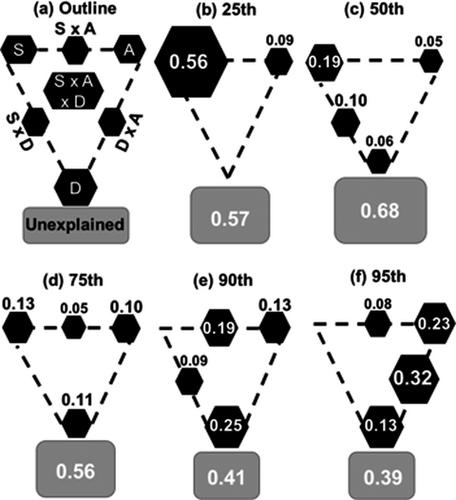当前位置:
X-MOL 学术
›
Glob. Change Biol.
›
论文详情
Our official English website, www.x-mol.net, welcomes your
feedback! (Note: you will need to create a separate account there.)
Peaks of in situ N2O emissions are influenced by N2O‐producing and reducing microbial communities across arable soils
Global Change Biology ( IF 10.8 ) Pub Date : 2017-09-13 , DOI: 10.1111/gcb.13853 Luiz A. Domeignoz-Horta 1 , Laurent Philippot 1 , Celine Peyrard 2 , David Bru 1 , Marie-Christine Breuil 1 , Florian Bizouard 1 , Eric Justes 3 , Bruno Mary 2 , Joël Léonard 2 , Ayme Spor 1
Global Change Biology ( IF 10.8 ) Pub Date : 2017-09-13 , DOI: 10.1111/gcb.13853 Luiz A. Domeignoz-Horta 1 , Laurent Philippot 1 , Celine Peyrard 2 , David Bru 1 , Marie-Christine Breuil 1 , Florian Bizouard 1 , Eric Justes 3 , Bruno Mary 2 , Joël Léonard 2 , Ayme Spor 1
Affiliation

|
Agriculture is the main source of terrestrial N2O emissions, a potent greenhouse gas and the main cause of ozone depletion. The reduction of N2O into N2 by microorganisms carrying the nitrous oxide reductase gene (nosZ) is the only known biological process eliminating this greenhouse gas. Recent studies showed that a previously unknown clade of N2O‐reducers (nosZII) was related to the potential capacity of the soil to act as a N2O sink. However, little is known about how this group responds to different agricultural practices. Here, we investigated how N2O‐producers and N2O‐reducers were affected by agricultural practices across a range of cropping systems in order to evaluate the consequences for N2O emissions. The abundance of both ammonia‐oxidizers and denitrifiers was quantified by real‐time qPCR, and the diversity of nosZ clades was determined by 454 pyrosequencing. Denitrification and nitrification potential activities as well as in situ N2O emissions were also assessed. Overall, greatest differences in microbial activity, diversity, and abundance were observed between sites rather than between agricultural practices at each site. To better understand the contribution of abiotic and biotic factors to the in situ N2O emissions, we subdivided more than 59,000 field measurements into fractions from low to high rates. We found that the low N2O emission rates were mainly explained by variation in soil properties (up to 59%), while the high rates were explained by variation in abundance and diversity of microbial communities (up to 68%). Notably, the diversity of the nosZII clade but not of the nosZI clade was important to explain the variation of in situ N2O emissions. Altogether, these results lay the foundation for a better understanding of the response of N2O‐reducing bacteria to agricultural practices and how it may ultimately affect N2O emissions.
中文翻译:

N2O排放量的峰值受到可耕土壤中产生和减少N2O的微生物群落的影响
农业是陆地N 2 O排放的主要来源,强效的温室气体,也是臭氧消耗的主要原因。n的减少2 ö成N 2由携带一氧化二氮还原酶基因(微生物nosZ)是唯一已知的生物过程消除这种温室气体。最近的研究表明,以前未知的N 2 O还原剂(nos Z II)进化枝与土壤作为N 2 O汇的潜在能力有关。但是,对于这个群体如何应对不同的农业实践知之甚少。在这里,我们调查了N 2 O生成器和N 2为了评估N 2 O排放的后果,O-还原剂受到一系列耕作系统的农业实践的影响。氨氧化和反硝化的丰度通过实时定量PCR定量,nosZ进化枝的多样性通过454焦磷酸测序确定。还评估了反硝化和硝化的潜在活性以及原位N 2 O排放。总体而言,在站点之间观察到的微生物活动,多样性和丰度差异最大,而不是每个站点的农业实践之间。为了更好地了解非生物和生物因子对原位N 2的贡献在O排放方面,我们将59,000多个现场测量结果细分为从低速率到高速率的各个部分。我们发现低N 2 O排放速率主要是由土壤性质的变化(高达59%)引起的,而高N 2 O排放速率是由微生物群落的丰度和多样性变化(高达68%)引起的。值得注意的是,nos Z II进化枝的多样性而不是nos Z I进化枝的多样性对于解释原位N 2 O排放的变化很重要。总而言之,这些结果为更好地了解减少N 2 O的细菌对农业实践的反应以及其最终可能如何影响N 2 O排放奠定了基础。
更新日期:2017-09-13
中文翻译:

N2O排放量的峰值受到可耕土壤中产生和减少N2O的微生物群落的影响
农业是陆地N 2 O排放的主要来源,强效的温室气体,也是臭氧消耗的主要原因。n的减少2 ö成N 2由携带一氧化二氮还原酶基因(微生物nosZ)是唯一已知的生物过程消除这种温室气体。最近的研究表明,以前未知的N 2 O还原剂(nos Z II)进化枝与土壤作为N 2 O汇的潜在能力有关。但是,对于这个群体如何应对不同的农业实践知之甚少。在这里,我们调查了N 2 O生成器和N 2为了评估N 2 O排放的后果,O-还原剂受到一系列耕作系统的农业实践的影响。氨氧化和反硝化的丰度通过实时定量PCR定量,nosZ进化枝的多样性通过454焦磷酸测序确定。还评估了反硝化和硝化的潜在活性以及原位N 2 O排放。总体而言,在站点之间观察到的微生物活动,多样性和丰度差异最大,而不是每个站点的农业实践之间。为了更好地了解非生物和生物因子对原位N 2的贡献在O排放方面,我们将59,000多个现场测量结果细分为从低速率到高速率的各个部分。我们发现低N 2 O排放速率主要是由土壤性质的变化(高达59%)引起的,而高N 2 O排放速率是由微生物群落的丰度和多样性变化(高达68%)引起的。值得注意的是,nos Z II进化枝的多样性而不是nos Z I进化枝的多样性对于解释原位N 2 O排放的变化很重要。总而言之,这些结果为更好地了解减少N 2 O的细菌对农业实践的反应以及其最终可能如何影响N 2 O排放奠定了基础。

































 京公网安备 11010802027423号
京公网安备 11010802027423号